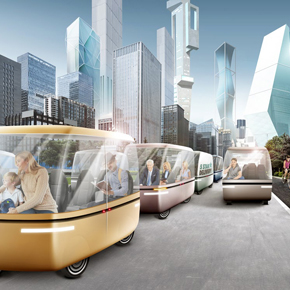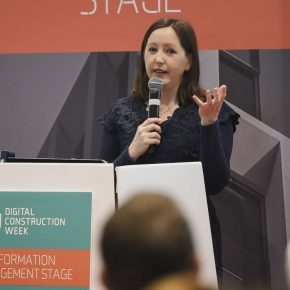
Back to the Future of Construction: Space ports, exoskeletons and virtual reality
To celebrate the 30th anniversary of Back to the Future, futurologist Ian Pearson has taken a trip a further 30 years down the line to predict what the world of construction may look like in 2045.
2045: Constructing the Future predicts a world of superhuman AI; half-human, half-machine exoskeletons and self-driving transportation ‘pods’.
Constructing the Future
Manufactured using ultra-strong, carbon-based materials, his report predicts that buildings will utilise advanced AI to adopt their very own personalities.
‘Smart buildings’ will collect and process sensor data, and help maintain all the various infrastructure and human comfort systems within the structure.
Advances in 3D printing will allow for the rapid construction of basic structures, and the extensive use of carbon nanotubes and graphene to reinforce building materials will enable stronger, lighter and taller buildings.
The tallest skyscrapers – up to 30 km tall – will act as mini-cities, many of which will house their very own space ports as space travel becomes a popular method of transportation.
Virtual architecture
As the use of augmented reality becomes more widespread, Ian suggests that it will greatly impact the visual appearance of our surroundings.
By 2045 we could see most buildings become windowless, instead featuring a simple planar surface, with more intricate details projected through the use of augmented reality. This way a cheap building can appear exactly the same in AR as an expensive one.
Virtual reality will also introduce marketing campaigns, artificial plants and animals into our surroundings to stimulate the visual environment.
Half human, half machine
The report speculates that most construction work will be completed with the use of super-strength exoskeletons.
Exoskeletons will convert builders into ‘transfomer-like’ workers, capable of lifting heavy loads and attaching special equipment to complete difficult tasks.
The heavy machines will work with a variety of attachments, including shape shifting technologies to help cut through materials, making cleaner edges and surfaces.
Augmented reality will also be utilised to allow the builders to see exactly where things should go and what the finished project is meant to look like to ensure the job is completed properly.
Transportation pods
Self-driving cars, similar to those currently being developed by Google, will be used universally by 2045 and almost entirely fleet managed, with private ownership rendered obsolete.
The electric vehicles will greatly reduce financial costs, pollution, congestion and accidents.
Vehicles, or ‘pods’, will be developed with the ability to share energy preserves, reducing their environmental impact and the need for external power sources.
Whilst these pods won’t hover, in special high-impact areas some vehicles may levitate on magnetic cushions, requiring partly metal road surfaces.
Back to the Future
Ian’s report concludes by suggesting that construction in 2045 will still share many of the same goals the industry faces today. Whilst automation and robots will be the biggest changes, the continued development of 3D printing and augmented reality will also have a significant effect on the way the industry operates.
Whilst we’re still waiting on some of the things promised in Back to the Future, the 2045: Constructing the Future report gives us plenty more to look forward to in the next three decades of construction.
Read 2045: Constructing the Future in full here
Latest news

30th April 2025
Digital Construction Week announces seminar programme for its landmark 10th edition
Digital Construction Week (DCW) returns to ExCeL London on 4 – 5 June 2025 with its most impactful programme yet. It brings together the best and brightest from across AECO, for two days of practical learning and idea sharing.
Posted in Articles, Building Industry Events, Building Industry News, Building Products & Structures, Building Services, Building Systems, Exhibitions and Conferences, Information Technology, news, Restoration & Refurbishment, Retrofit & Renovation, Seminars
29th April 2025
Senior pledges to ‘bee’ part of the solution with new biodiversity initiative
Senior Architectural Systems has installed its first on-site beehive, marking another step forward in its commitment to sustainability and biodiversity.
Posted in Articles, Building Industry News, Building Products & Structures, Building Services, Curtain Walling, Doors, Glass, Glazing, Innovations & New Products, news, Restoration & Refurbishment, Retrofit & Renovation, Sustainability & Energy Efficiency, Walls, Windows
29th April 2025
West Fraser range delivering key benefits for South-East carpentry company
An experienced carpenter and building site manager who has recently set up his own company is using high performance panel products from the West Fraser range.
Posted in Articles, Building Industry News, Building Products & Structures, Building Systems, Case Studies, Garden, Restoration & Refurbishment, Retrofit & Renovation, Sustainability & Energy Efficiency, Timber Buildings and Timber Products
29th April 2025
CPD Courses Available Online From Ecological Building Systems
Ecological Building Systems, a leading supplier of natural building products for sustainable construction, has revealed its comprehensive CPD programme for the year ahead.
Posted in Articles, Building Industry Events, Building Industry News, Building Products & Structures, Building Services, Continuing Professional Development (CPD's), Information Technology, Innovations & New Products, Insulation, Restoration & Refurbishment, Retrofit & Renovation, Seminars, Sustainability & Energy Efficiency, Training, Walls, Waste Management & Recycling
 Sign up:
Sign up: 